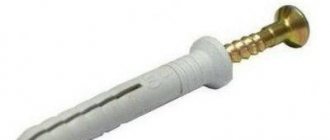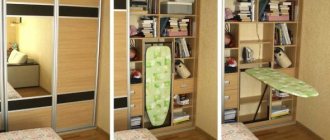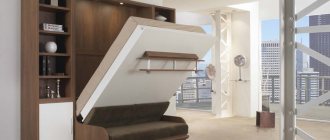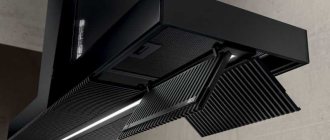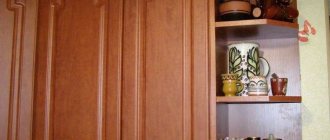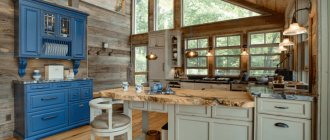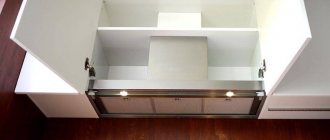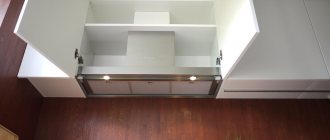Norms and requirements
The correct size of a kitchen hood will ensure maximum performance of the device. That is why you should approach this issue responsibly.
The main criterion when calculating sizes is width. Why is that? Manufacturers indicate in the technical documentation that the width should be larger or correspond to the dimensions of the hob. Therefore, the device is installed strictly above the stove. The type of stove (induction, electric or gas) does not matter.
No specific standards are specified. The main thing that must be observed is the optimal distance to the stove to ensure fire safety.
The most common kitchen hoods on the market are 60 cm wide. If the figure is 990 cm or more, this will increase productivity and allow you to cover a larger volume in a certain time. Under no circumstances should the device be narrower than the hob. This can lead to a third of the emissions bypassing the hood and settling on the ceiling.
Hood height
Height is also important: it should be chosen taking into account the type of device and the dimensions of the room. It is recommended to leave a distance of at least 75 cm for a gas stove and at least 65 cm for an electric stove between the surface of the hob and the hood.
By height, all models are divided into:
- low,
- standard,
- tall.
Low models with a minimum height of 10 cm and a maximum of up to 40 cm are usually island or wall-mounted, as well as built-in. For example, the small wall-mounted Kaiser A 501 NB, the most affordable, has a height of 32 cm, and the built-in narrow Elica CIAK GR/A/56 with a retractable panel is 20 cm.
Standard models with heights from 40 to 90 cm - all possible types. Among the most popular is the island model Korting KHA 7950 X Cube, cubic in shape with a height of 72.7 cm.
Tall models up to 140 cm are designed for very large rooms and are considered as a decorative element. Among them there are many fireplace and inclined models, for example, the classic Falmec Melissa Tulip 90 (600) S stained oak 102 cm high with natural wood trim.
Voting: best cabinet hood
Which closet hood will you choose? Which one do you recommend for purchasing?
Elica HIDDEN IX/A/60
22.73% ( 10 )
Konigin Insait Inox 60
9.09% ( 4 )
Elica BOX IN IX/A/60
6.82% ( 3 )
Bosch DHI 642 EQ 60 WH
15.91% ( 7 )
Kuppersberg SLIMLUX II 60 XFG
9.09% ( 4 )
MAUNFELD Crosby Push (2m) 60
9.09% ( 4 )
Korting KHP 6313 X
6.82% ( 3 )
LEX GS BLOC Light 600 WH
6.82% ( 3 )
ELIKOR Integra 60
6.82% ( 3 )
Selecting the optimal hood width
The dimensions of the hood are more important for the design of the room, and do not in any way affect the performance and technical characteristics of this equipment. Therefore, it is possible to find the optimal width of the appliance only in combination with the dimensions of the hob and kitchen unit.
Modern hoods can be from 35 to 120 cm wide. The main selection criterion is the dimensions of the stove. Manufacturers of household appliances offer models of hoods with the following widths:
- 35 cm;
- 45 cm;
- 50 cm;
- 60 cm;
- 80 cm;
- 90 cm;
- 100 cm;
- 120 cm.
The range of built-in hobs has the same characteristics. But full-fledged gas or electric stoves are most often produced with a width of 50-60 cm. Hoods with such parameters are the most popular. On average, for the correct choice of equipment, they are guided by two recommendations:
- The dimensions of the exhaust, working surface of the device are important, and not the dimensions of its body.
- The width of the exhaust surface must correspond to the same geometric indicator of the slab.
The most successful in this regard are built-in models.
Due to the retractable panel, the area of the device increases. As for hanging ones, the standard width of a kitchen hood is 60 cm. It is optimal for rooms with an area of 12-18 m2. Appliances with such parameters fit harmoniously into the set, since the standard width of cabinets and wall cabinets is also 60 cm.
In small kitchens, the best choice would be a two-burner built-in hob and a kitchen dome or flat 45 cm wide hood located above it.
Models built into the table
Hoods built into the table
, are retractable structures that are installed behind the hob or on the side of it. Less common are non-retractable models built into the countertop - for example, BORA CKASE. To install them, you need a cabinet under the hob. When not in use, these devices are almost invisible.
BORA built-in desk hoods
De Dietrich built-in table hoods
BORA built-in desk hoods
Miele built-in desk hoods
Their sizes vary widely depending on the design and installation location. Thus, the Miele CSDA 7000 FL model, installed flush on the side of the hob, is 12 cm wide and 52 cm deep. The De Dietrich DHD7261B pull-out model, installed behind the hob, is 118 cm wide, the height of the hidden part is 74 cm and the retractable part is 30 cm.
Optimal sizes of built-in and hanging hoods for the kitchen
A 60 cm wide hood is the optimal solution for standard kitchens in multi-storey buildings. The retail chain offers many models of wall-hung and built-in types with a width of 60 cm. The design of the devices is very different, which allows you to find the most suitable design.
When choosing a built-in hood, take into account the parameters of the selected kitchen unit. Standard furniture sets may not be suitable. With a custom-made kitchen, such problems will not arise.
If the exhaust system must perform not only the function of air purification, but also ventilation of the room, powerful models are chosen. As a rule, they are distinguished by impressive dimensions. But there are also many high-performance devices with small geometric parameters. The best model will be the one that harmoniously fits into the kitchen design.
How to choose a hood for the kitchen - design features and appearance
In order for the exhaust panel to bring real benefits, the following parameters are taken into account when choosing: performance, operating mode, umbrella size and design.
When the device is selected correctly, it provides 6-fold or 10-fold air exchange (depending on the mode) due to powerful fans. The hood must cover the hob completely.
Built-in models
They are located in the cabinet or on the countertop. This design is almost invisible and takes up minimal space. Suitable for small kitchens (up to 10 m). These air ducts have many configurations and are easy to match to any style of room.
Built-in panels are located horizontally or vertically, have 1-4 filters, can come with a control panel included, have backlighting and an on/off timer.
In such designs, odors and fumes pass through the filter, where they are cleaned and returned to the kitchen in the form of clean air, while grease settles on the filter.
Important! When operating such an appliance, do not open the window in the kitchen so that the appliance does not “swallow” and waste power on air from the street.
Hanging hood
It is easy to install, compact and comes in a variety of designs. But it is not suitable for a large kitchen, as it has low power and performance. Such a device is attached to the wall or ceiling and is not connected to the ventilation of the living space.
Suspended panels have a single-stage (the smell goes into the ventilation hatch) or two-stage air purification, in which it passes through a grease filter, then through a carbon filter, and then comes out clean into the room.
Dome hood
The device is ideal for spacious rooms. It is similar to a fireplace duct, always the same shape, but in two different positions: inclined or horizontal.
Of all types, this is the highest quality option, as it is made of stainless steel, has a durable coating, and can continuously purify the air using two filters: grease-absorbing and carbon. These are dual-motor devices with touch screen controls.
Reference. New types of modern hoods: “domino”, which is built into the countertop and is pulled out only during cooking, and “island” - a hanging structure above the stove, located in the center of the kitchen.
What to look for when choosing depth and height
These parameters must also be taken into account when arranging the cooking area. Let's look at how to choose the right depth and width of cleaning equipment.
Depth selection
This parameter is taken into account for dome and built-in air vents. Modern models of dome hoods are square in shape, that is, the depth of these devices is equal to their width. Accordingly, the depth dimensions also start at 45 cm and end at 90 cm. The choice of a square shape is not accidental: hobs are also produced with equal width and depth parameters. And, as we already know, the hood cannot have an area smaller than the stove over which it is installed.
With built-in models the situation is different, because the depth can be adjusted during the planning process. However, its body must match the size of the wall cabinets.
Built-in recirculation models are often equipped with a retractable panel, which increases their depth and, accordingly, their operating efficiency.
Height selection
If your choice fell on a dome-type hood, then the maximum height of such a structure can be 125 cm. This must be taken into account when purchasing: if you subtract the height of the stove from the height of the kitchen ceilings, then the remaining number must be no less than the standard values determined by safety regulations. The minimum distance between the slab and the bottom surface of the exhaust structure is:
- for a gas hob – at least 65 cm;
- for electric stoves - at least 60 cm.
For inclined hoods, the installation height should be slightly lower:
- for gas stoves - 550-650 mm,
- for electric and induction surfaces - 350-450 mm.
There is no need to reduce the height: a dangerous situation will arise and the hood may be damaged. Setting it higher is also not recommended because it will reduce efficiency.
It should be noted that for recirculating hoods there is no such selection problem. After all, these are flat devices that can be installed at any required height.
The smaller the distance between the kitchen air vent and the burners, the higher the possibility of condensation forming from the bottom of the hood from rising water vapor.
This table will help you choose the correct size of the cleaning device:
| Features of the room | Hood height | Instrument depth | Width | Hob width |
| A large room | The height of the appliance is selected depending on the height of the room and the type of cooking unit | Depth parameters correspond to width dimensions | The ideal option would be dimensions that are larger than the hob | The width can be any: a wide cooking area looks natural in a spacious room. It is the main accent in the interior. |
| Small room | The height of the device compensates for the small dimensions of the stove, which saves space | Depth parameters correspond to width dimensions | Do not choose a wide hood, take a closer look at compact models | For a small room, choose a stove with a narrow countertop |
When choosing a hood for the kitchen, you need to take into account many nuances, but the most important criteria are size and performance. First you need to decide what functions the cleaning equipment should perform: air purification, extracting foreign odors, or simply as a design item. Then you should measure the hob and kitchen area. After you have decided on the basic parameters, you need to choose a brand and model based on preferences and taste.
General recommendations for safe installation
But in order for any model of hood to work efficiently and fulfill its functions, it must be installed correctly. This task is best left to professionals.
So, the following factors influence the height of the hood:
- standard recommendations;
- type of stove or hob;
- the presence or absence of ventilation, as well as its power;
- device performance;
- hood dimensions;
- user height.
Since the main task of the device is to purify the air above the hob, when calculating the height you should base it, first of all, on the type and size of the stove itself.
There are stoves: gas, electric, induction and halogen. A special feature of the latter are Hi-Light burners.
To operate effectively, the hood must completely cover the hob area. Thanks to this, all polluted air will be recycled. If the stove is wider, then harmful impurities and unnecessary odors will remain in the kitchen.
For fire safety reasons, standard height parameters between the hood and the burners have been developed.
When compiling them, the type of stove and the design of the lower part of the hood are taken into account. It can be straight or inclined.
For gas stoves, the height from the burners to the straight hood is from 75 to 85 cm, and to the inclined hood – 55-65 cm.
For electric, induction and halogen surfaces, the height from the burners to the direct hood is from 65 to 75 cm, and to the inclined hood – from 35 to 45 cm.
This difference in height is explained by the absence or presence of open fire and the risk of ignition of fat and soot particles on the filters
Often the manufacturer himself prescribes the required height. This is dictated by the characteristics of the materials from which the filters and the device itself are made. The material may be particularly flame resistant and/or have some special features.
You can deviate from the established standards by a maximum of 5-10 centimeters. The distance can only be increased, and reduced only if the power allows and the height of the cook requires it. In any case, before making a final decision, you should consult a specialist.
Professional installation will allow the device to perform its functions better and more efficiently (to extract all excess and purify the air), and will also save energy, since you will not have to turn on the hood at maximum power.
In addition, the height between the hood and the hob is affected by the performance of the hood itself. Sometimes this indicator is called power and is measured in cubic meters. m/hour. Before purchasing a hood, it is worth calculating at least an approximate value.
The quality of air purification directly depends on productivity. Also, if the device has sufficient power, you can adjust the height of the hood above the hob.
It is worth noting that power is also affected by the presence or absence of ventilation and the number of family members who smoke. Additional creases and right angles of the duct can only reduce the performance and increase the noise of the hood
No. 1 - installing a hood over a gas stove
There are many requirements for appliances that are installed above a gas stove. First, you need to accurately measure the distance from the bottom of the device to the hob. As mentioned above, it should be within 75-85 cm.
This distance is slightly greater than when installing the device above an electric model due to the fact that an open flame can ignite the hood filters, especially if they are heavily dirty.
Also, we should not forget that in the case of gas stoves, natural ventilation must work. Therefore, during installation, you cannot completely block the ventilation hole in the kitchen.
To avoid this, you can purchase special grilles for air ducts, divided into two parts: one for connecting the hood, and the other for natural ventilation.
The extraction power is also a very important parameter. Before purchasing a unit, it is necessary to accurately calculate it. A little below will be written about how to do this correctly.
Having carried out the necessary calculations and measurements, it is worth remembering that you cannot buy a device with less power than that obtained in the calculations. Otherwise, it will just be money thrown away; such a device will not cope with the task assigned to it
Do you want to install a hood over a gas stove yourself? In this case, we recommend watching the step-by-step installation instructions.
No. 2 - distance to the electric stove
More lenient requirements are being put forward for electric models. First of all, this concerns the installation height of the hood above the device - it can be reduced slightly, since these models are considered safer to use than gas models.
If the kitchen space is small, then the best option would be to opt for a built-in or flat hood model. In addition to convenience, the prices for such devices are affordable for most citizens.
Another important factor that needs to be taken into account when placing the device above the hob is the dimensions of the stove. So, the width and length of the hood should not be less than the same parameters of the slab. Otherwise, grease and soot will accumulate on the furniture.
The hood above an electric stove can be placed a little lower than above a gas stove, since the former are a little safer to use
Important rules for installing a hood
If you are planning to mount the air intake yourself, study in advance the rules that guide the installation. This is especially true for the standards and requirements for the height of the hood above a gas stove:
- The width of the hood and the size of the hob should always match for optimal performance of their functions, or be slightly larger. The main requirement is that it is no narrower than the slab.
- According to standards, the distance from the hood to the stove depends on the type of hob, as specified in the instruction manual.
- Install the outlet to which the device is connected as far as possible from the stove. It’s good when it is located above the kitchen unit or hidden behind the cabinet doors. Wires must be placed far from sources of ignition.
- There should not be many corners and turns in the duct itself and the place where the hood is connected to the air duct. Otherwise, the air, encountering many obstacles, will escape with difficulty and unnecessary noise.
- It is necessary to observe the standards for the height of the hood above the gas stove, which are described in the instructions for the equipment in order to avoid fire. There are no general distance limits according to GOST from a gas stove to a kitchen hood, but they exist for every manufacturer. You can familiarize yourself with them in the operating manual. It is worth adhering to these recommendations when determining the height of the hood above the gas stove.
- If there is no ventilation shaft, you should choose the circulation option. It is much easier to install.
Save
Carrying out measurements and calculations
As you can see, it is quite difficult to take into account all the factors and make an accurate calculation. But you need to try not to regret purchasing a device that cannot cope with the tasks assigned to it.
There are criteria developed by manufacturers:
- A device with a capacity of 200 to 300 cubic meters. m/hour is suitable for those who cook little or have a small kitchen. That is, 1-2 burners are constantly used.
- Hood with a capacity of 300 to 400 cubic meters. m/hour is recommended for families of 3-4 people, or for a medium-sized kitchen, as well as where 2-3 burners are used daily.
- A device with a capacity of 500-600 cubic meters. m/hour will clean the air in a large kitchen and cover the needs of a large family. Such a hood will be indispensable if the stove is actively used every day and all burners are turned on (there may be 5-6 of them).
For approximate indicators, you can use special tables or data from manufacturers.
To quickly calculate productivity, two values are used: kitchen area and ceiling height. These approximate data can be multiplied by the slab coefficient
If the kitchen has non-standard dimensions or its area does not exceed 40 cubic meters. m, then calculate this value for a specific room by simply multiplying the length of the kitchen by its width and the height of the ceilings. The result must be multiplied by 10 or 12
The numbers 10 or 12 are constant coefficients based on sanitary standards. They mean that the air must be cleaned every 5 minutes, that is, 10-12 times per hour. Therefore, productivity exceeds the volume of the kitchen by at least 10-12 times.
Sometimes this coefficient increases due to the frequency of switching on and the characteristics of the stove used. For example, for a gas stove with large burners that are turned on every day, this number can reach 20. For an electric stove, you can take a factor of 15.
If the stove is non-standard and is cooked daily, then to calculate productivity it is worth using additional coefficients for the number of floors, for the stove, for smokers. But you should not purchase a device with a large power reserve
For example, the length and width of the kitchen are 2 and 3 m, respectively, and the ceiling height is 2.5 m.
Therefore, the estimated productivity will be: 2 * 3 * 2.5 * 10 = 150 cubic meters. m/hour .
This figure can be multiplied by the number of storeys factor of 1.3. It meets sanitary standards.
If someone smokes in the kitchen, then another 15% is added to productivity for each smoker of the total number.
The data obtained is correct for enclosed spaces. If the kitchen is not closed by a door, but is separated from other rooms by a passage, then another 30% of the received power should be added.
On our website we have detailed instructions for calculating a kitchen hood.
The next indicator is the height of the cook . It is very important that the hood does not touch your head and does not interfere with reaching distant burners or placing large pans.
Therefore, before purchasing and installing, take measurements and simulate the process of working behind the stove. To avoid mistakes when taking measurements, remember that an inclined hood should be measured from the lowest point to the burners.
All straight hoods (dome or built-in) should be measured from the filters to the slab surface.
Experts recommend choosing inclined hoods for electronic, halogen and induction cookers. They do not require much space and do an excellent job of purifying the air.
You should also take into account the length of the hood . Determine how far it will protrude above the hob, how convenient it will be to cook and replace charcoal and grease filters, as well as wash the stove and reach distant burners.
All described factors affecting the distance must be consistent. Otherwise, there is a risk that the hood will not cope with its tasks. Even the most powerful device installed too high will not cope with all the impurities in the air. Or soot that has settled on the bottom of a hood that is installed too low may ignite.
A competent choice of installation height will extend the life of the hood and allow the device to work at full capacity with minimal costs. In the worst case, the device may not cope with its functions or simply burn out.
The best built-in hoods for the kitchen: TOP 10
| Photo | Name | Rating | Price | |
| #1 | Elica HIDDEN IX/A/60 | ⭐ 99 / 10010 — votes | Find out the price | |
| #2 | Konigin Insait Inox 60 | ⭐ 98 / 1004 — votes | Find out the price | |
| #3 | Elica BOX IN IX/A/60 | ⭐ 98 / 1003 — votes | Find out the price | |
| #4 | Bosch DHI 642 EQ 60 WH | ⭐ 97 / 1007 — votes | Find out the price | |
| #5 | Kuppersberg SLIMLUX II 60 XFG | ⭐ 96 / 1004 — votes | Find out the price | |
| #6 | MAUNFELD Crosby Push (2m) 60 | ⭐ 95 / 1004 — votes | Find out the price | |
| #7 | Korting KHP 6313 X | ⭐ 94 / 1003 — votes | Find out the price | |
| #8 | LEX GS BLOC Light 600 WH | ⭐ 93 / 1003 — votes | Find out the price | |
| #9 | ELIKOR Integra 60 | ⭐ 92 / 1003 — votes | Find out the price | |
| #10 | GERMES Chester 60 BK | ⭐ 91 / 1003 — votes | Find out the price |
Which closet hood will you choose? Which one do you recommend for purchasing?
Take the survey
We suggest that you familiarize yourself with the rating of the TOP 10 models of built-in hoods with a width of 60 cm, which are most often positively evaluated by users on the Internet and even recommended for purchase. Please note that our editors compiled this list based on an analysis of reviews and ratings posted on various sites by those who have already used the product. We do not recommend considering the rating as a guide to purchase: you should choose the model that you like. But it’s still worth getting acquainted with the options that other users liked. The list includes hoods in a variety of price categories.
GERMES Chester 60 BK
GERMES Chester 60 BK
This is an inexpensive and because of this very popular model of a built-in pull-out hood. It can be built directly into the wall cabinet above the stove and used while cooking - nothing superfluous
The model’s productivity is 600 cubic meters per hour, the width required for installation, as required, is 60 cm. The device has two fairly powerful and efficient engines. The power of the option is 190 W. The model is characterized by fairly quiet operation and has reliable mechanical control that will never let you down.
Users note that this model is of very high quality despite the fact that it is quite inexpensive. And it performs its functions with a bang. In addition, it is easy to clean and can be easily washed off from fatty deposits. The main drawback is that it is difficult to extend and retract; you need to make an effort to pull the device out. Otherwise, it’s a worthy option for any kitchen.
pros
- low cost
- two engines
- easy to clean
- mechanical convenient control
- works quietly
Minuses
- difficult to slide in and out
Prices for hood GERMES Chester 60 BK
Hood GERMES Chester 60 BK
ELIKOR Integra 60
ELIKOR Integra 60
A good and inexpensive hood, which is built into a wall cabinet directly above the stove, from where it is pulled out if necessary, using a special mechanism. Currently considered one of the best models on the market in 2021 in its price category.
Productivity - 400 cubic meters per hour. But at the same time, the power is slightly more than that of the option described above and amounts to 200 W. The device is equipped with mechanical control and backlight. It is very light, does not put a lot of stress on the headset, but has thin metal.
Judging by what users write, this model is reliable, durable and high quality. You can connect it through the ventilation shaft, and also use it by installing a carbon filter - it captures odors perfectly. It is also reported that the hood is a little noisy, but not at a critical level, but quite tolerable. On the market now this is one of the most optimal hoods in terms of price-quality ratio.
pros
- low cost
- easy to use
- reliable and high quality
- good power
- captures odors well
- good manufacturer
Minuses
- a little noisy
- thin metal body
Prices for hood ELIKOR Integra 60
Hood ELIKOR Integra 60
Reviews of hoods ELIKOR Integra 60
LEX GS BLOC Light 600 WH
LEX GS BLOC Light 600 WH
A good hood for its price that can be built into a wall cabinet. Very light and beautiful. This is one of those purchases that can really please the user and certainly will not disappoint him.
Productivity - 500 cubic meters per hour, power - only 80 W. The device is equipped with a mechanical control system and has a very quiet motor, which means it makes virtually no noise. The surface is non-staining - the hood does not need constant cleaning to look neat. Backlight is also available.
Buyers note the cute design of the device. Moreover, it is not striking, but simply does its job. The price is very reasonable and is also one of the advantages of this model. Intuitive and simple controls will allow everyone to use the hood.
pros
- low cost
- cute but discreet design
- convenient control
- light weight
- quiet
- does not require constant cleaning
Minuses
- not detected
Prices for hood LEX GS BLOC Light 600 WH
Hood LEX GS BLOC Light 600 WH
Korting KHP 6313 X
Korting KHP 6313 X
Stylish and attractive hood in a beautiful color that matches harmoniously with a variety of hobs. It has excellent aluminum grease filters that perfectly clean the air from various combustion products and fats.
The hood can operate in two modes - recirculation and vapor removal. You can use any one you choose. Productivity is 600 cubic meters. m/h, power 250 W. The device is equipped with two motors and is controlled using mechanical buttons. You can install carbon filters inside if you wish. They do an excellent job of removing cooking odors. There is also a backlight and a retractable panel, which allows you to increase the area from which air will be captured for purification.
Silence during operation is what users primarily note. The hood is quite effective and does an excellent job of its task, that is, collecting and trapping odors released by food during cooking. Three operating modes make it possible to cook a wide variety of dishes. Among the shortcomings, not very good build quality and poor packaging were noted - you will have to try hard to remove all the film covering from the metal.
pros
- works quietly
- grease filters
- three operating modes
- stylish look
- good performance
- convenient control
- carbon filters included
Minuses
- not very good build quality
Prices for hood Korting KHP 6313 X
Hood Korting KHP 6313 X
Reviews of hoods Korting KHP 6313 X
MAUNFELD Crosby Push (2m) 60
MAUNFELD Crosby Push (2m) 60 stainless steel
A productive hood, which is often chosen by users precisely because of this parameter. The maximum productivity of the device is 750 cubic m/h. This is a fully built-in option that is unlikely to disappoint the buyer.
The power of the hood is 190 W, it has two motors, and they are quite quiet. The controls are mechanical and not at all complicated, which anyone can master.
As users note, the hood is really powerful and high quality. The noise emitted during operation of the device, which is small for such productivity, makes it possible to cook in the kitchen in comfort. The product collects all odors very well. By the way, it is very easy to clean.
Disadvantages - the lighting is not always well-executed; light bulbs may start blinking. Otherwise, the option is very good for its reasonable price.
pros
- good build
- catches odors perfectly
- good value for money
- high performance
- convenient control
Minuses
- as such, no noise was detected, except for a little noise, but with such performance you can’t do without it
Prices for hood MAUNFELD Crosby Push (2m) 60
Hood MAUNFELD Crosby Push (2m) 60
Kuppersberg SLIMLUX II 60 XFG
Kuppersberg SLIMLUX II 60 XFG
An elegant model that is also highly efficient. The hood has simple controls, a stylish design - nothing superfluous.
Productivity is 550 cubic meters. m/h, the power is 260 W. The device can be switched to either air exhaust or recirculation mode - whichever is more convenient. The metal filter is easy to wash if necessary, and you can even put it in the dishwasher. The area under the hood is illuminated by two bulbs. The panel slides out very easily, allowing you to expand the vapor capture area. The control is convenient mechanical.
As users note, the device operates quite quietly and is very easy to use. The stylish and simple design is pleasing - the hood does not spoil the appearance of the kitchen unit. It captures odors one hundred percent, and cleaning is very simple and does not cause problems. No deficiencies were found as such.
pros
- catches odors perfectly
- easy to clean
- neat design
- good performance and power
- retractable panel for better odor capture
- quiet operation
Minuses
- not detected
Prices for the Kuppersberg SLIMLUX II 60 XFG hood
Hood Kuppersberg SLIMLUX II 60 XFG
Bosch DHI 642 EQ 60 WH
Bosch DHI 642 EQ 60 WH
An excellent hood from a well-known brand manufacturer of a wide variety of electronic devices and equipment. High build quality, good operating efficiency and reliability are the main characteristics of this model.
Productivity is only 300 cubic meters. m/h, in recirculation mode - slightly less, and power - 181 W. The control is mechanical with slide switches and is quite convenient. The hood can operate both in circulation mode and in ventilation mode. It has only one engine and low noise level. Inside there is a good grease-absorbing filter that can be washed in the dishwasher, and a carbon version can be purchased and installed separately.
This hood can be safely installed in small kitchens - in this case, it will cope with the task of capturing odors with a bang. Three speed modes make it possible to cook even very aromatic dishes without worrying that the smell will spread throughout the apartment. A retractable screen will increase the area of odor capture.
pros
- high build quality
- famous and reliable brand
- catches odors perfectly
- low noise level
- light weight
- good grease filter
- three operating modes
Minuses
- Suitable only for small kitchens
Prices for hood Bosch DHI 642 EQ 60 WH
Hood Bosch DHI 642 EQ 60 WH
Reviews of hoods Bosch DHI 642 EQ 60 WH
Elica BOX IN IX/A/60
Elica BOX IN IX/A/60
Electronically controlled hood, characterized by high performance and relatively low noise levels. Stylish and modern, it will decorate any kitchen.
The productivity of the device is high and equal to 750 cubic meters per hour. The power is 210 W. And this is the first model in our rating that has electronic control. The engine is quiet and does not irritate even people who are used to cooking in silence. The hood can be installed in rooms up to 15 square meters.
Among the advantages of the model, users note its beautiful appearance, backlighting and ease of use. By the way, opinions are divided regarding the noise of the product: for some it works quietly, for others it is noisy, however, the noise is noted only at the highest speed. Disadvantage - it cannot work in recirculation mode, it only vents air into the ventilation shaft. And its price is noticeably high, and not everyone can buy such a hood.
pros
- high build quality
- high productivity
- beautiful appearance
- almost silent
- electronic control
- Ease of use
Minuses
- high price
- only mode of air exhaust into the ventilation shaft
Prices for hood Elica BOX IN IX/A/60
Hood Elica BOX IN IX/A/60
Konigin Insait Inox 60
Konigin Insait Inox 60
A hood that, after installation, will not give a single reason to doubt the correctness of the choice. An excellent option, characterized by reliability and good performance.
This built-in device has a high level of productivity, which is equal to 750 cubic meters per hour. Its power is 170 W. The model can operate in both exhaust and recirculation modes - who prefers which option. The control is electronic; you can also turn on the hood remotely. The noise level is very low. By the way, the hood even has a display.
As customers note in their reviews, the device has an excellent design and high build quality. The hood looks like it can be installed in absolutely any interior, and it will not disturb the harmony. Although there are those who refute this statement. The taste and color, as they say... The power is enough to capture all the kitchen odors. And it really makes virtually no noise, and the controls are intuitively simple.
pros
- high build quality
- high performance indicators
- quiet operation
- recirculation mode and exhaust mode
- there is a display
- remote control
- nice design
Minuses
- not detected
Prices for Konigin Insait Inox 60 hood
Konigin Insait Inox 60 hood
Elica HIDDEN IX/A/60
Elica HIDDEN IX/A/60
We deservedly put this hood in first place in the rating. This is the most productive model among those described in this material, which does not have retractable elements, but perfectly collects all odors in the kitchen. It is compact in size and stylish in appearance.
Maximum productivity is 1200 cubic meters. m/h, and power - 262 W. It can operate in two modes - recirculation and discharge into the ventilation shaft. Electronic control. Absorption of odors is carried out perimetrically.
As users note, the hood is really very productive and powerful. Moreover, its dimensions are quite small. There are no retractable elements, and it is easy to integrate it anywhere in the headset. The main disadvantage is the high noise level. And this is perhaps the only drawback. Overall, this hood does its job perfectly.
pros
- high build quality
- high performance
- good power
- small sizes
- two operating modes - drainage and circulation
- no retractable elements
- can be embedded anywhere
Minuses
- makes a lot of noise
Prices for hood Elica HIDDEN IX/A/60
Hood Elica HIDDEN IX/A/60
Reviews of hoods Elica HIDDEN IX/A/60
What else to consider during installation?
Before installation, you should consider the specifics of connecting the device to the network.
Any hood is connected to the electrical network. Therefore, the socket should be installed at a height of 2 -2.5 meters from the floor and 15-25 cm above the wall cabinets.
Such an outlet must be grounded so that the hood does not burn out due to power surges. Never install an outlet in line with an air duct. Aim for about 15-20 cm from it.
Also, when taking measurements, it is worth considering the distances to the side cabinets. Aim for 5-10 cm in both directions.
We have provided diagrams of the location of sockets in the kitchen and the details of their installation with our own hands in the following material.
When making calculations, it is very important to take into account all pieces of furniture and wiring in the kitchen and draw a diagram of the location of each item
For example, let's look at a specific situation. The dome hood must be installed above a 5-burner gas stove in a 31-cu.m. kitchen. m, ceiling height 2.8 m. Cooking is done on the stove every day, the kitchen is closed with a door.
First, let's find out the approximate power. Let’s take the coefficient 20 due to the number of burners and the frequency of use of the stove: 31 * 2,8 * 20 = 1736.
Thus, this kitchen requires a hood with a capacity of at least 1800 cubic meters. m/hour.
The stove will be used by a person with a height of 170 cm, the height of the stove is 75 cm, and the height of the hood is 60 cm. Therefore, we compare all the data and get an approximate range of 77-80 cm for the height of the hood.
It is important to carry out such calculations to avoid errors during installation. But it’s best if you have the opportunity to check the conventional arrangement of equipment in the kitchen and the ease of its use.
Covered area
It is very important that the model you choose can “pull” the area of your kitchen. In other words, it is recommended to give preference to the hood whose power is sufficient to “drive” the air in the room in 5-10 minutes.
For this purpose, order a model whose recommended area is 10-20% higher than the square footage of the kitchen.
Many manufacturers already indicate this indicator in the product description, so you don’t have to calculate it manually.
